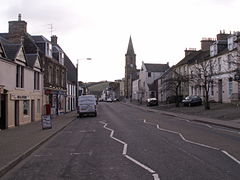- Newburgh, Fife
-
Coordinates: 56°21′06″N 3°14′18″W / 56.3517°N 3.2383°W
Newburgh
Newburgh High Street and central tower
 Newburgh shown within Fife
Newburgh shown within FifeOS grid reference NO234183 Council area Fife Lieutenancy area Fife Country Scotland Sovereign state United Kingdom Post town Cupar Postcode district KY14 Police Fife Fire Fife Ambulance Scottish EU Parliament Scotland List of places: UK • Scotland • Newburgh is a royal burgh of Fife, Scotland having a population of 2040 (est 2004). Newburgh has grown little since 1901 when the population was counted at 1904 persons.
It is situated on the Firth of Tay, 7 m. N.W. of Ladybank Junction alongside the Edinburgh to Aberdeen railway line (between Perth and Ladybank). Newburgh railway station closed in 1951 (pre-Beeching), and has never reopened in spite of local campaigns for its reinstatement. Fife Scottish (now Stagecoach in Fife) used to have a depot at East Shore Road. But the depot closed in 1991, and nowadays Newburgh is an outstation of Glenrothes depot; three double deckers are parked overnight every night.
For some time, its industries chiefly consisted of the making of linen and floorcloth, malting and quarrying, and there were fisheries, especially of salmon. The harbour was used for the transshipment of the cargoes of Perth-bound vessels of over 200 tons. But most of these industries have now gone. A linoleum factory, owned by Courtaulds, which had been the town's principal employer, closed in May 1980 after a large fire destroyed much of the building. After many years of lying derelict, the factory has since been completely demolished and cleared and its site is now a recreational waterfront. Local services and a few shops provide limited employment, but most residents now commute to larger towns. However, one quarry, for many years owned by Bell Brothers, is still operational, and is now owned by Ennstone Thistle. T Robertson & Sons, of Whinpark Quarry, still run a road contractors' business, although the quarry itself is no longer in operation.
Contents
Local structures
Town house
The plain Georgian town house, with central tower and spire, was built on the south side of the High Street in 1808. It forms a continuous block with the other houses. The Laing Museum and Library was added to the north side of the street in 1894-96. Museum open in summer only.
Macduff's Cross
On high ground, about a mile southwest at 56°20′20″N 3°14′44″W / 56.339°N 3.2455°W, stand the remains (only the pedestal) of Macduff's Cross,[1] which (in legend) marks the spot where the clan Macduff in return for its chief's services against Macbeth was granted rights of sanctuary and composition for murder done in hot blood.
Denmylne Castle
Denmylne Castle[2](15th century?), about a mile south-east of Newburgh at 56°20′39″N 3°12′55″W / 56.3443°N 3.2154°W on the Cupar road, was the home for more than 250 years of the Balfour of Denmylne family, of which the two brothers, James (1600–1657), the annalist and Lyon King, and Andrew (1630–1694), founder of the Botanic Garden in Edinburgh, were the most distinguished members. The Castle was abandoned in 1772 when the estate was sold, now stands within a 19th century steading whose construction will have necessitated the removal of the Castle's subsidiary buildings. It been unroofed for at least 200 years and is in an increasingly dangerous state of disrepair. A lintel dated 1620 has been re-used in one of the steading's building.
Lindores Abbey
Lindores Abbey is situated near the Tay, on the East side of the town. Of the Tironensian (reformed Benedictine) abbey, founded about 1190 by David, Earl of Huntingdon, brother of William the Lion, there are only fragmentary remain, although the ground plan of the whole structure can still be traced. Best preserved are the south-west gateway through the precinct wall, various discontinuous fragments of the wall itself, and part of the east cloister range, including the still vaulted slype (passage from the cloister to the east end of the church), all built of local red sandstone. The monastic church itself had a single aisle on the north side, with aisled north and south transepts, a central tower (presumably) and a detached western tower or campanile, as at Cambuskenneth Abbey.
The monks were noted agriculturists and their orchards famous. Many of the houses in Newburgh's High Street have orchards with trees descended from the original plantings, although many plots have now been sold and developed for housing. Numerous architectural fragments from the Abbey are built into buildings in the town.
Natural areas nearby
Nearby Lochmill Loch — 56°19′56″N 3°15′32″W / 56.3322°N 3.2590°W — has been dammed to provide the town with a water supply and fishing.
At Blackearnside, a forest of alders, to the east of the village, Wallace defeated Aymer de Valence, 2nd Earl of Pembroke in 1298.
Mugdrum Island, opposite the large Mugdrum estate from which it takes its name, ("ridge of the pig[s]" in Gaelic), is offshore in the Firth dividing it into 'North Deep' and 'South Deep' channels. For many years cattle were ferried over to the island for summer grazing, but this is no longer practised.
Sport
Newburgh is home to the junior football club Newburgh F.C.
References
 This article incorporates text from a publication now in the public domain: Chisholm, Hugh, ed (1911). Encyclopædia Britannica (11th ed.). Cambridge University Press.Newburgh is also home to Newburgh Sailng club and is an RYA recognised training centre
This article incorporates text from a publication now in the public domain: Chisholm, Hugh, ed (1911). Encyclopædia Britannica (11th ed.). Cambridge University Press.Newburgh is also home to Newburgh Sailng club and is an RYA recognised training centre
External links
- Newburgh Bear
- [1] Newburgh station campaign
Categories:- Towns in Fife
Wikimedia Foundation. 2010.



